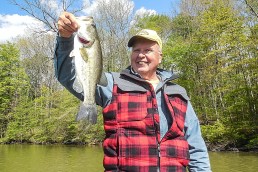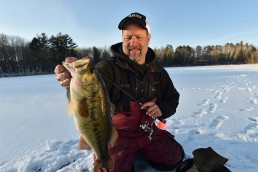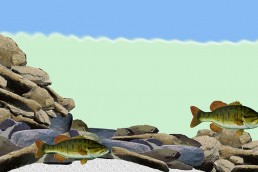Spring Bass: From Ice Off through Spawning
SHARE THIS POST
Catching early spring bass is a challenge for many anglers. The waters are cold and often the fish are nowhere to be found. Well, Richie Glavac is an Ohio angler who has solved the mystery of catching pre-spawn and spawning bass. Best of all, once mastered, his techniques are not terribly complex. Some might say that they are deadly simple. Here are his secrets.
“I will start fishing for bass as soon as the ice leaves the lake,” said Glavac. “The water temperature is in the upper 30s to low 40s at this time. The bass aren’t real aggressive, but they are feeding on baitfish.”
Surprisingly, on many Ohio Lakes, Glavac starts his early spring fishing near the deeper midsections of the lake. Sometimes he is even fishing near the dam areas. In the coldest waters, he fishes the longer creek arms and coves off the main lake. These creek arms are shallower and have a feeder creek that sends warmer water into them. The bass, because of the warmer waters, are a little more active than those in the main lake.
Target locations
He pays special attention to swings (turns) in the creek arm’s channel. Next, he watches his locator for patches of dead weeds on the lake bottom. While he likes to fish a moving bait, he does not fish them real fast. Rather, he crawls them along. Rat-L-Traps are one of his favorite spring lures. Silver/black back, and crayfish are his two favorite colors for this lipless crankbait. Usually he fishes a half-ounce model. However, if he is looking for a kicker (lunker) in a tournament, he ties on a ¾-ounce Rat-L-Trap.
After casting the lure out, he lets it sink to the bottom. Slowly he crawls it just above the dead weeds. When it ticks something, he jerks the rod tip skyward. After this, he lets the lure fall back towards the bottom. This is the time when the bass are most likely to hit. He continues this retrieval method all the way back to the boat. He considers the Rat-L-Trap to be a search bait for finding pre-spawn bass.
Proven methods
At this time of the year, Glavac also likes crankbaits with a tight-wobbling action. Shad Raps that run 10 feet or shallower work well in these cold-water conditions. His go-to color is silver with a black back. He cranks the bait down to the bottom and starts a stop-and-go technique. After cranking a few feet, he stops and lets the lure sit there for a few seconds. Next, he lifts the spinning rod tip up to about 11:00 o’clock. He retrieves the slack line as he is dropping the rod tip to within a foot of the water. He continues the stop-and-lift method during the entire retrieve. He will vary the time he pauses the lure until he finds what the bass want.
His third go-to lures are jerk baits—Lucky Craft Pointers. He prefers the 78 or 100 sizes. Shad colors, such as silvers or white with black backs, work well for him in pre-spawn waters. Cast to a likely looking area and crank it down to the desired depth. Now, use the rod tip to work it erratically, like a jerkbait. Give the rod tip two or three jerks in a row and then pause. Start out by letting the lure sit still for a couple seconds. If that does not produce, add a couple more seconds to the delay. Some days the bass want the lure motionless for 8 or 10 seconds.
Points to pick
In the main lake, after the ice has been off a week or two, he also starts fishing long points on the main lake. Work those that taper down into the reservoir’s deeper waters. Here the pre-spawn fish start staging on these long points, waiting to move up into the spawning areas. On these points, he uses the same lures and retrieving methods that he fishes in the creek arms.
On his spinning reels, he spools 10-pound-test fluorocarbon line when fishing jerkbaits and crankbaits. For Rat-L-Traps, his baitcasting reels have 14 or 17-pound-test Berkley Professional fluorocarbon.
Are you enjoying this post?
You can be among the first to get the latest info on where to go, what to use and how to use it!
These methods described are used for the first four or five weeks after ice off. To summarize these methods, work the bait slowly and close to the bottom. At this time of the year, the majority of hits will be on the pause or fall.
About the third or fourth week after ice off, the buck males start frequenting the spawning areas. The females are staging in nearby deeper waters.
“My experiences have shown, that the females come up in waves,” said Glavac. “Usually in late April, I see the big females staging for the first wave. It seems like the biggest females are in the first wave. Others follow after them.”
Fishing the woods
Glavac’s favorite areas to look for spawning bass are willows. However, if there is a big submerged stump or tree near the spawning sites, fish it. Often big bass sit on those big trees before moving into the shoreline to spawn. When searching for bass in the shallows, he often casts a 3/8-ounce spinnerbait in water depths of four feet or less. He likes a tandem willow leaf and Colorado-bladed model with a chartreuse or white skirt.
Once the fish are on the beds, he flips to them. His favorite flippin’ bait is a green pumpkin 4-inch Zoom Brush Hog. He Texas rigs it on a size 3/0 extra-wide-gapped Gamakatsu hook. On the line, he uses either 1/8 or 1/4-ounce slip sinker unpegged. He always is looking for the big bass in brush near the spawning grounds
If a cold spell drives the bass off the beds, he uses his ice-off lures and methods. He fishes them at the point’s first structure break or on the channel bends in the creek arm bays.
There is one last item about spawning bass. Glavac says, when searching for spawning fish, the shallow ends of the lake see some of the earliest spawners. Next, they tend to start spawning on shorelines off the lake’s deeper waters. These waters warm more slowly. An exception would be long creek arm bays that are near deep water. These long bays also are early spawning areas.
Glavac’s favorite early ice out Ohio lakes are the Portage Lakes, Mogadore, and Mosquito. Later in the spring, he also likes LaDue and Berlin Reservoirs.
This spring, enjoy some great bass fishing from ice off until post spawn by using Richie Glavac’s proven methods.
MWO
SHARE THIS POST
Did you enjoy this post?
You can be among the first to get the latest info on where to go, what to use and how to use it!
Paul Liikala
Paul Liikala was raised on a farm which was close to Lake Erie and the Grand River. He was fortunate to have parents who nurtured his love for the outdoors. His only hope is that his writings show the love and admiration that he has for the Great Outdoors and its participants.



